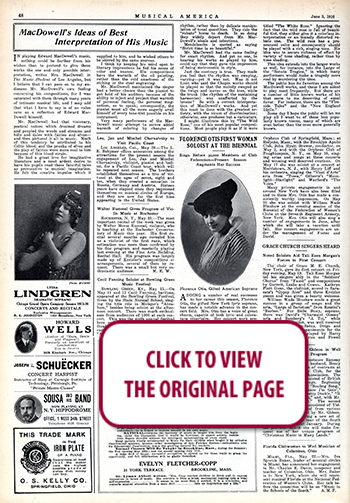 100 YEARS AGO IN MUSICAL AMERICA (146)
100 YEARS AGO IN MUSICAL AMERICA (146)
June 3, 1916
Page 48
MacDowell’s Ideas of Best Interpretation of His Music
IN playing Edward MacDowell’s music, nothing could be farther from his wishes than to pretend to give these works the one and only possible interpretation, writes Mrs. MacDowell in The Music Student of Los Angeles, but I believe that I can pass on to my audiences Mr. MacDowell’s own feeling concerning his compositions, for I was saturated with them through many years of intimate musical life, and I may add that what I have to say is of no value save as a reflection of Edward MacDowell himself.
Mr. MacDowell had that visionary, poetical nature which dreamed dreams and peopled the woods and streams and hills and dales with fairies and elves and then pictured it all in music. Much of this tendency he attributed to his Celtic blood, and the pranks of elves and the play of fairies were more real to him because of this blood strain.
He had a great love for imaginative literature and a most ardent desire to have his pupils read these fanciful tales as provocative to musical imagination. He felt the creative impulse which it supplied to him, and he wished others to be stirred by the same sources.
I think by keeping his mind open to literary impressions he fed his sense of color and nuance. His compositions have the warmth of the oil painting, rather than the cold exactness of the etching or the steel engraving.
Mr. MacDowell maintained the singer had a better chance than the pianist to get hold of his auditors because of the ability to inject and project that warmth of personal feeling, the personal magnetism, so to speak; consequently, the pianist must all the more eagerly avail himself of every tone-tint possible on his instrument.
Very many performers Dowell music attempt to warmth of coloring by of the MacDowell music attempt to secure added warmth of coloring by changes of rhythm, rather than by delicate manipulation of tonal quantities. They ride the “rubato” horse to death. In so doing they widely depart from Mr. MacDowell’s ideals and intentions.
Mendelssohn is quoted as saying “Strict time is so beautiful.”
Mr. MacDowell had the same feeling for exact rhythm. And yet no one, in hearing his works as played by him, could say that they gave the impression of being metronomic in style.
Just the contrary is true. They made you feel that the rhythm was swaying, varying—yet it was not. Was it not Liszt who said the Chopin works should be played so that the melody swayed as the twigs and leaves on the tree, while the trunk (the rhythm of the sustaining harmonies) was unaffected by the breeze? So with a correct interpretation of MacDowell’s works. And yet this must be done with the greatest artistry, with the nicest of discrimination; otherwise, one produces but a caricature.
I might illustrate this by “The Wild Rose,” one of his most popular compositions. Most people play it as if it were titled ‘‘The White Rose.” Ignoring the fact that the wild rose is full of beautiful tint, they either give it a colorless interpretation or an inanely distorted rubato one. The wild rose has a pronounced color and consequently should be played with a rich, singing tone. His idea was to secure richness of effect by variety of tone shading, rather than by time shading.
This idea extends into the larger works as well; for instance, into the Largo of the “Sonata Tragica,” in which many performers would make a tragedy more real by murdering the time.
The public has its favorites among the MacDowell works, and these I am asked to play most frequently, But there are a number of little known works of his that seem to me deserving of equal favor. For instance, there are the “Fireside Tales” and the “New England Idylls.”
Some day I hope the public will let me play all I want to of these less popularly known pieces, many of which are even better than the ones more generally known.




 RENT A PHOTO
RENT A PHOTO





